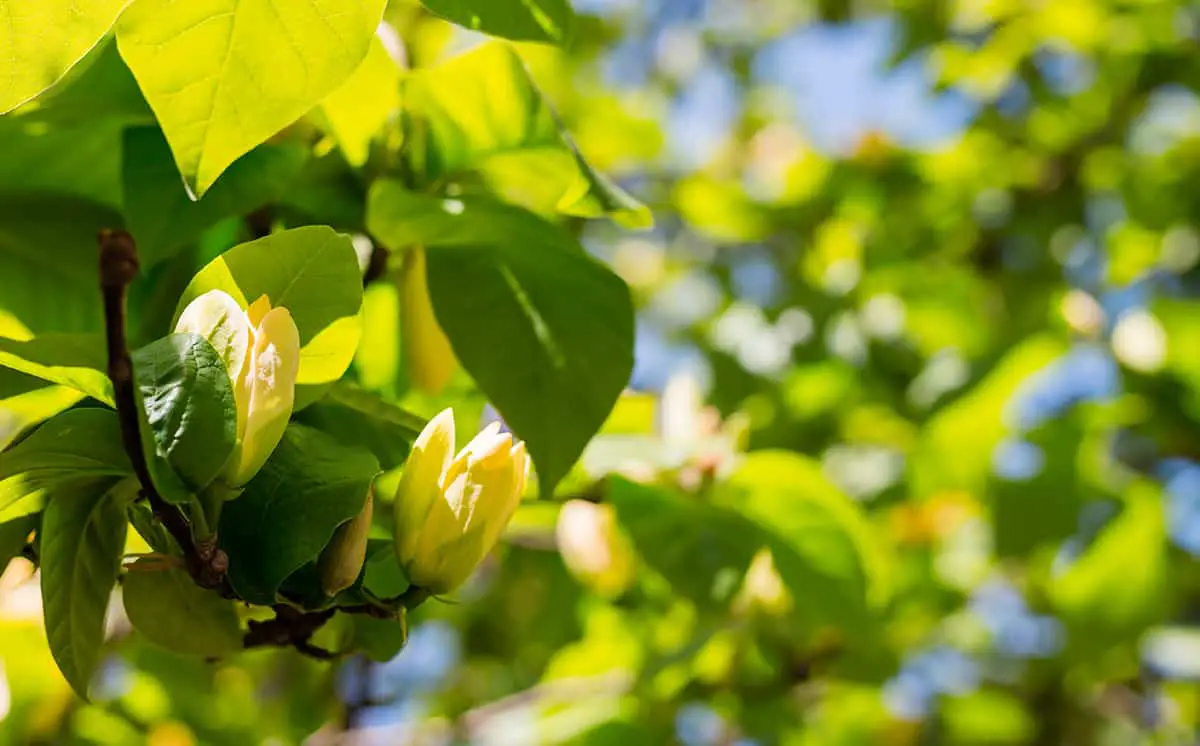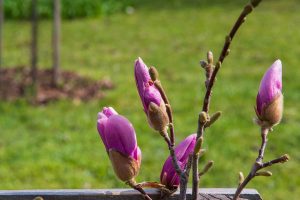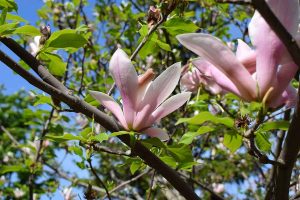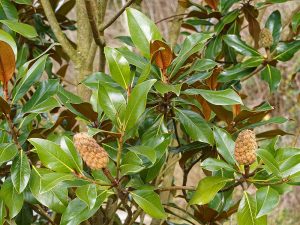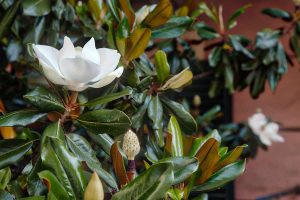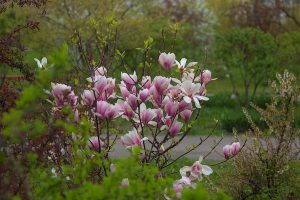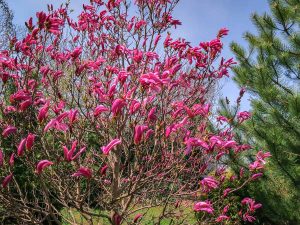The Yellow Bird Magnolia Tree is one of the modern magnolia hybrids. It was created in 1981 by the Brooklyn Botanical Gardens, as a hybrid resulting from crossing the Cucumber Tree Magnolia (Magnolia acuminata var. subcordata) and the Magnolia x brooklynensis ‘Evamaria’, which itself is also a hybrid. The result is a stunning tree which is remarkable when in flower.
The Yellow Bird Magnolia can be grown as a very large shrub or a small to medium-sized tree. It grows in a pyramidal or conical shape, and is deciduous. Flowers bloom in late spring as the fresh foliage is just starting to unfurl on the previously bare branches. A profusion of blooms covers the tree, in a delicate lemon-yellow color.
Each flower stands upright on its branch, measuring 3 inches across. Flowers typically remain on the tree for around 3 weeks. The foliage of the tree is elliptical, in a medium green color. During fall, the leaves develop into a golden-tan color before the tree sheds.
- Botanical name: Magnolia × brooklynensis ‘Yellow Bird’
- Common names: Yellow Bird Magnolia,
- Plant family: Magnoliaceae
- USDA hardiness zone: 4- 8
- Mature height: 40 feet
- Mature spread: 30 feet
Table of Contents
Varieties of Yellow Bird Magnolia
Magnolia x brooklynensis ‘Evamaria’
This magnolia is one of the parent plants of the Yellow Bird Magnolia. It is a hybrid named after Dr. Evamaria Sperber, who worked at the Brooklyn Botanic Garden’s scientific research and development center in Ossining, New York, and was a founder of the breeding programme. This magnolia was patented in 1968, as the BBG’s first introduced hybrid. The plant is a cross between the Lily magnolia or Mulan Magnolia (Magnolia liliiflora ‘Nigra’) and the Cucumber Tree (Magnolia acuminata).
It is a medium-sized tree that produces colorful flowers which are predominantly purple but flushed with yellow or orange. It blooms late in spring, like the Yellow Bird Magnolia, which means it escapes the damage of late frosts and can be relied upon for a spectacular floral display every year.
Magnolia × brooklynensis ‘Hattie Carthan’
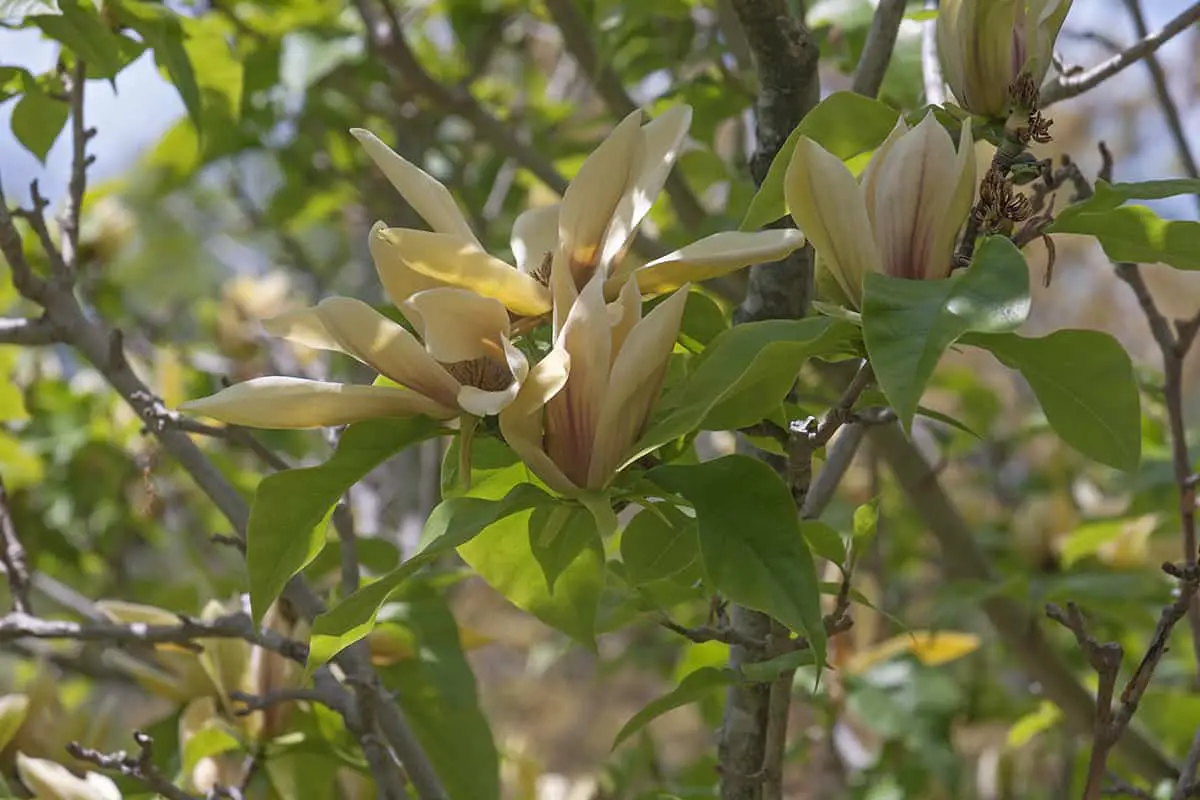
Like the Yellow Bird Magnolia, the Hattie Carthan Magnolia is a second-generation hybrid, with the Magnolia x brooklynensis ‘Evamaria’ being used as one of the plant parents. The Hattie Carthan Magnolia was developed by the Brooklyn Botanic Gardens, and named in honor of Hattie Carthan, who was the founder of the Magnolia Tree Earth Center in Brooklyn, New York.
She also served on the board of trustees for the Brooklyn Botanic Gardens. The plant itself is a variety of yellow magnolia, producing unusual flowers which are predominantly yellow but have contrasting purple veins. The tree blooms late in spring like the Yellow Bird Magnolia, allowing it to escape from potential damage caused by late frosts.
It is hardy down to USDA zone 5, and is known for being a fast growing tree. It is fairly small in stature, growing to a typical height of around 20 feet, with a similar-sized spread.
How to Care for your Yellow Bird Magnolia Tree
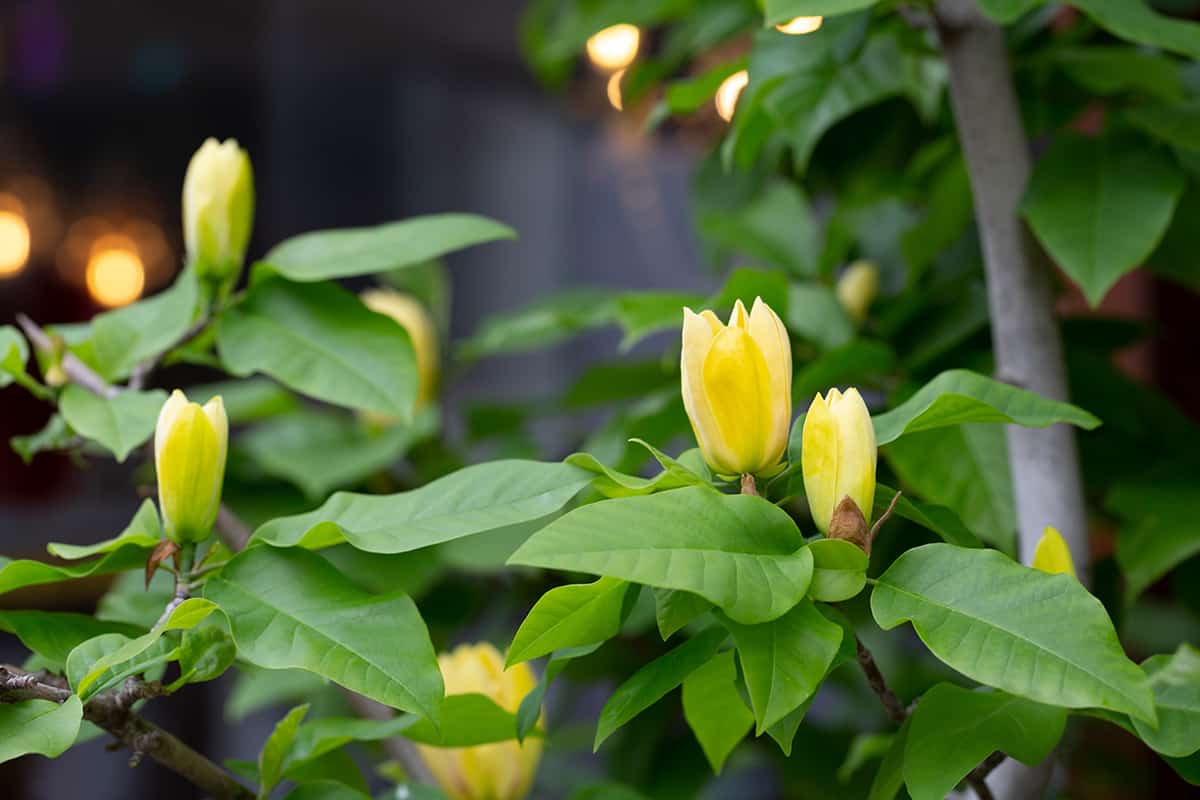
Light
The Yellow Bird Magnolia grows best in either full sun or partial shade. It should ideally be planted in a south-facing or west-facing position, with some shelter from winds in the form of a fence, wall, or other larger plants.
A good amount of natural light is essential for the magnolia to flower effectively. If you find that the tree is not producing many flowers, or it isn’t blooming at all, then this may be due to insufficient lighting levels.
Soil
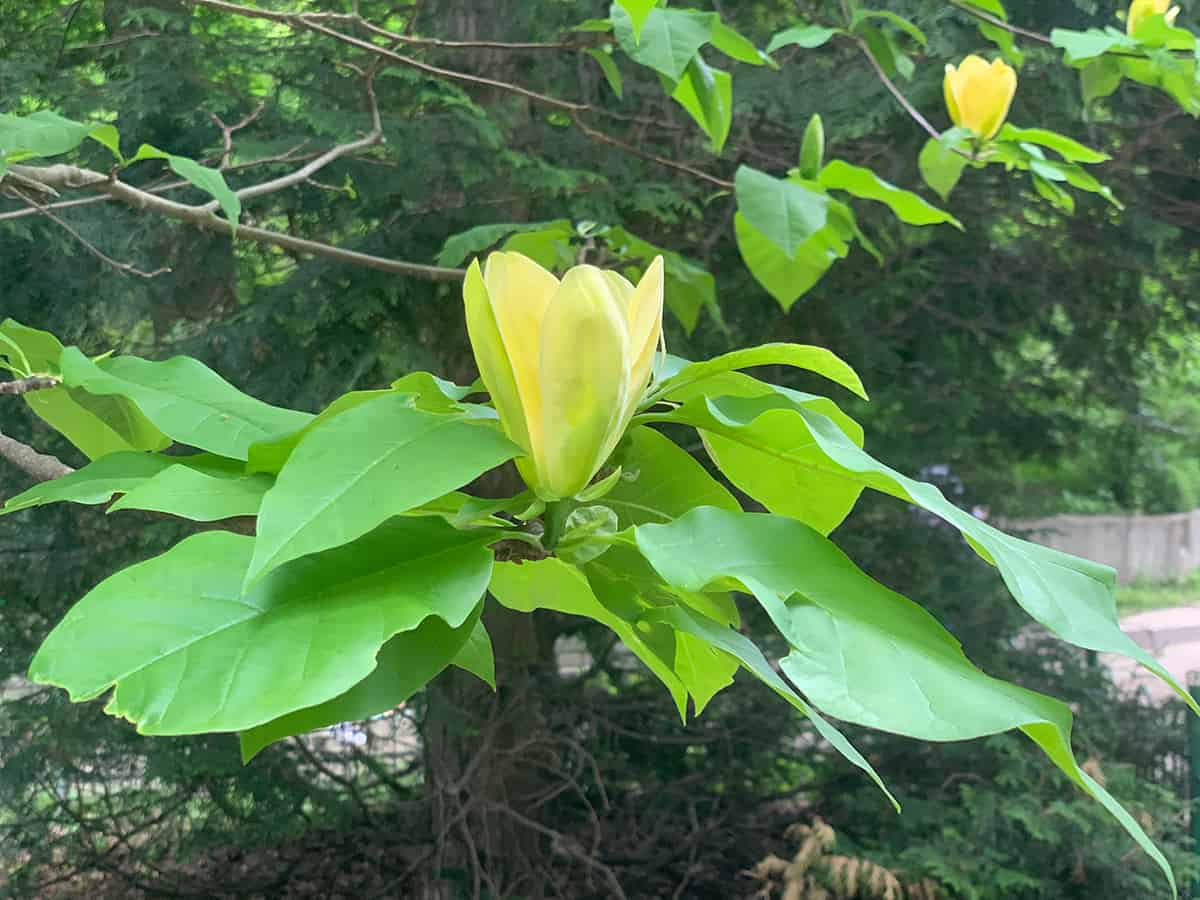
Magnolias are adaptable to a variety of soil types, but they grow best in soil that has a high organic content, is consistently moist, and drains well. To encourage the Yellow Bird Magnolia to thrive, grow it in soil that is slightly acidic. Though the plant will grow in neutral or alkaline soil, it has a preference for acidic soils and will perform best when grown in this type of soil.
You can check the pH of your soil to determine whether it is already acidic, or if it needs supplements to alter the pH level, by using a soil test kit. If the soil pH needs to be lowered to make it more acidic, this can be done in a variety of ways. You can feed the soil with lemon or vinegar, add compost to the soil, or apply a pine needle mulch over the top of the soil.
The Yellow Bird Magnolia tree will adapt to alkaline soils, though it will likely experience slower growth or a smaller eventual size. The most important thing to get right when it comes to a magnolia’s soil is its ability to drain well. Though magnolia’s can tolerate a wide range of soils, even having the capacity to adapt to clay or loamy soils, they will not withstand waterlogged soils.
Any soil you plant the Yellow Bird Magnolia in will need to be well-draining, whether that be ground soil or potting soil in a container. Add sand or perlite to your soil mix to make it drain better. As this plant likes to be kept in consistently moist soil, a soil that drains well is essential to ensure any excess moisture can drain away, rather than resulting in soggy, waterlogged soil.
Water
Magnolias love moist conditions, so generous watering is essential for this plant. It will thrive in climates with regular rainfall, but in dry periods you will need to supplement with additional watering to meet the plant’s needs. It is not tolerant of drought, and a lack of water can have numerous negative effects on the magnolia.
Moist soil throughout fall and winter is especially important, as this can alter the number of blooms that are produced the following spring. As the Yellow Bird Magnolia likes for its roots to be kept moist, well-draining soil is essential to prevent waterlogging or root rot.
This plant is also susceptible to honey fungus, which is a disease more likely to occur in soil that is overly wet. A well-draining soil will allow the plant to get the moisture it needs without drowning it.
Temperature
The Yellow Bird Magnolia is a hardy variety of magnolia which grows well in USDA hardiness zones 4 to 8. It can survive in temperatures as low as -30°F without sustaining any damage, so it’s a great specimen for growing even in regions that experience heavy snow and below-freezing conditions.
Many hardy magnolias suffer from damage to their flowers because they will bloom early in spring when there is still frost in cold climates. Fortunately, the Yellow Bird Magnolia is less susceptible to this problem, because the flowers will not usually bloom until later in spring.
If a late frost occurs, the flower buds could sustain damage, which they do not typically recover from. This could mean a sad floral display for the coming season, but the tree will be able to recover and bloom again the following year.
Fertilizer
The Yellow Bird Magnolia can benefit from fertilizer feeds, but this isn’t essential if you have nutrient-dense soil in your local area. If you do fertilize your magnolia, this should be done once a year, either in the fall after all of the leaves have been shed, or early in spring just as the flower buds are developing.
This plant enjoys a boost of phosphorus and potassium, but fertilizer which is heaviest in nitrogen will be best. A suitable fertilizer ratio for the Yellow Bird Magnolia is 20-5-10 or 12-4-8. Avoid overfertilizing magnolias because their roots are susceptible to fertilizer burn. If you do not fertilize the plant, you can amend the soil by adding a layer of organic compost over the top of the soil. When it rains or the plant is watered, the nutrients from the compost will gradually seep into the depths of the soil beneath to feed the plant.
Yellow Bird Magnolia Tree FAQs
Why won’t my Yellow Bird Magnolia bloom?
If your magnolia isn’t blooming it may be that it isn’t mature enough yet. The plant will need to be several years old before it can produce flowers. If it is old enough, but still not flowering, then this is likely down to improper care. The Yellow Bird Magnolia needs plenty of water and sunlight to produce flowers. Some fungal diseases can also cause a magnolia to stop flowering, but this is difficult to diagnose.
Are Yellow Bird Magnolia Trees resistant to pests?
Most magnolias do not commonly suffer from pest infestations, though the Yellow Bird Magnolia can be susceptible to scale insects and snails. The tree is more likely to suffer from a fungal disease than a pest problem since these are unfortunately prevalent in plants that grow in moist soils. Fungal diseases to watch out for include honey fungus, and coral spot.
Can Yellow Bird Magnolias be pruned?
Magnolia trees do not need to be pruned unless you are removing dead or damaged growth. Pruning can cause harm to magnolias and should be avoided unless necessary.
